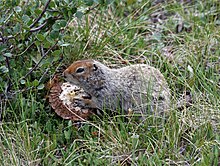Arctic ground squirrel
| Arctic ground squirrel | |
|---|---|
 |
|
| Scientific classification | |
| Kingdom: | Animalia |
| Phylum: | Chordata |
| Subphylum: | Vertebrata |
| Class: | Mammalia |
| Order: | Rodentia |
| Family: | Sciuridae |
| Genus: | Spermophilus |
| Species: | S. parryii |
| Binomial name | |
|
Spermophilus parryii Richardson, 1825 |
|
| Subspecies | |
|
10 ssp., see text |
|
| Synonyms | |
|
Urocitellus parryii |
|
10 ssp., see text
Urocitellus parryii
The Arctic ground squirrel (Spermophilus parryii or Urocitellus parryii) is a species of ground squirrel native to the Arctic. People in Alaska, particularly around the Aleutians, refer to them as "parka" (pronounced "par'kee") squirrels, most likely because their pelt is good for the ruff on parkas and for clothing.
Subspecies listed alphabetically.
The Arctic ground squirrel has a beige and tan coat with a white-spotted back. This squirrel has a short face, small ears, a dark tail and white markings around its eyes. Arctic ground squirrels undergo a coat change from summer to winter. Summer coats include red/yellow colorations along the cheeks and sides of the animal. In fall, these red patches are replaced with silvery fur. The average length of an Arctic ground squirrel is approximately 39 cm (15 in). Since Arctic ground squirrels undergo drastic seasonal changes in body mass, it is difficult to give an average mass, but for adult females it is close to 750 g (26 oz), however, males generally are around 100 g (3.5 oz) heavier than females.
The Arctic ground squirrel can be found in regions of Northern Canada ranging from the Arctic Circle to northern British Columbia, and down to the southern border of the Northwest Territories, as well as Alaska and Siberia.
The Arctic ground squirrel is native to the North American Arctic tundra, where its main habitats are on mountain slopes, river flats, banks, lakeshores and tundra ridges of the arctic tundra. Ground squirrels live in sandy soil due to easy digging and good drainage. Arctic ground squirrels make shallow burrows in areas where the permafrost does not prevent them from digging. The Arctic ground squirrel inhabits dry Arctic tundra and open meadows in the most southern habitats of this species.
The diurnal Arctic ground squirrel lives on the tundra and is prey to the Arctic fox, the red fox, wolverine, lynx, the grizzly bear, and eagles. It is one of the few Arctic animals, along with their close relatives the marmots and the un-related little brown bat that hibernate. In the summer it forages for tundra plants, seeds, and fruit to increase body fat for its winter hibernation. By late summer the male Arctic ground squirrel begins to store food in its burrow so that in the spring it will have edible food until the new vegetation has grown. The burrows are lined with lichens, leaves, and muskox hair.
...
Wikipedia

